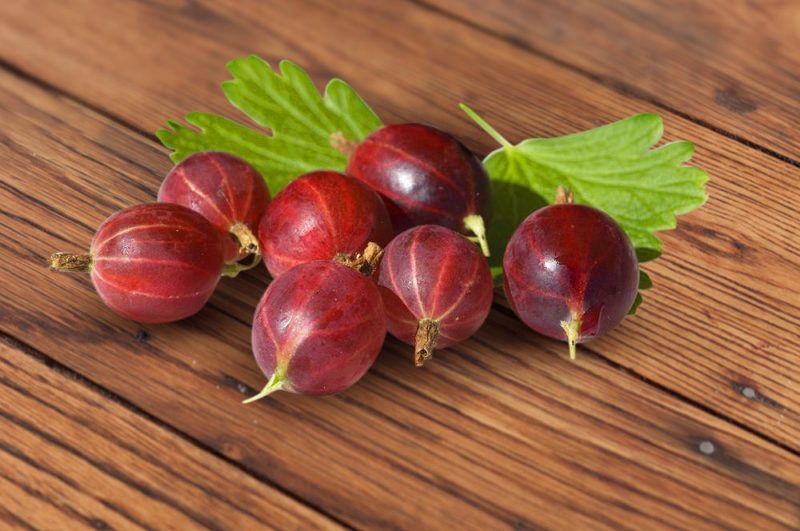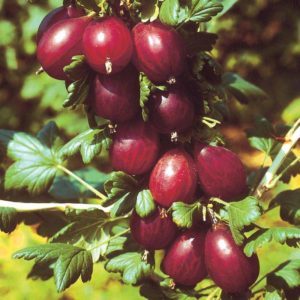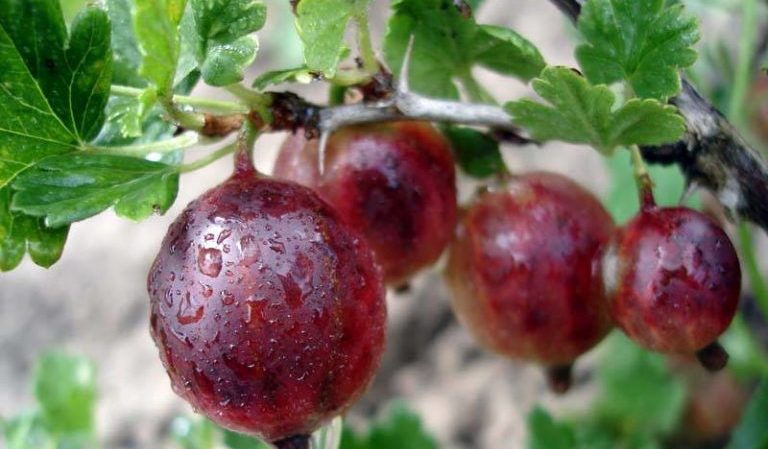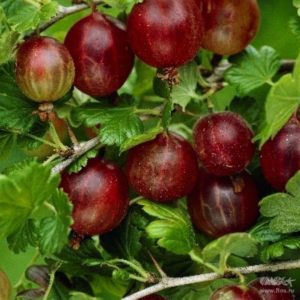Frost-resistant late-ripening gooseberry variety Spinefree
The gooseberry variety Spinefree was developed at the beginning of the 20th century and has not yet lost its popularity. This is due to a number of its advantages, including stable fruiting, immunity to diseases and pests, drought and frost resistance. Let's consider the technique of planting seedlings and the rules of care that are important to follow to obtain a rich harvest of berries.
What kind of gooseberry is this?
Spinefree is a late-ripening gooseberry variety; the berries ripen in late summer. The bushes begin to bear fruit 2-3 years after planting, the yield is 4-6 kg per plant.
The readiness of fruits for harvesting is judged by their color: they should turn dark red. The berries are stored in the refrigerator or cellar for no longer than 10 days.

History of origin and distribution
Spinefree gooseberries were bred by Canadian scientists in 1935 as a result of 2 generations of selection. So, initially the slightly thorny gooseberry was crossed with the Victoria variety, which resulted in the formation of completely thornless plants. To create Spinefree, they were crossed with the Canadian gooseberry variety Melby.
Description of Spinefree gooseberry
The plant is a tall shrub with long (1–1.2 m), powerful, arched, smooth or covered with a small number of weakly expressed shoots and a medium-spreading spherical crown.
The leaves are rich, bright green, large.
Temperature resistance
This is a frost-resistant variety.Bushes and roots tolerate drops in air temperature down to -30...-34°C, so Spinefree is successfully grown in all regions.
Moisture, drought resistance and immunity
The plant does not need frequent and abundant watering. The bushes tolerate hot weather well, and periods of prolonged drought do not provoke fruit shedding. At the same time, waterlogging of the soil increases the risk of rotting of the root system.
The variety is resistant to powdery mildew and other diseases characteristic of the crop and pests.
Characteristics and description of fruits
After the flowering period, which occurs in May, fruits appear on the bushes. At first, the skin of the berries is colored green, but as they ripen, the shade changes, and ripe fruits acquire a dark red color with green veins.
The berries are oblong-round, dense, weigh 4–6 g. The taste is dessert, sweetness predominates, a slight sourness is felt.
Areas of use
Spinefree berries are consumed fresh and used for processing: making preserves, jams, jellies, marmalade, wine and other preparations.
Advantages and disadvantages of the variety
The main advantages of Spinefree gooseberries:
- absence or a small number of thorns on the shoots;
- possibility of universal use of fruits;

- high degree of drought and frost resistance;
- stable fruiting;
- abundant yield;
- good keeping quality and transportability;
- excellent dessert taste;
- immunity to diseases and pests;
- self-fertility;
- ease of reproduction;
- no need for winter shelter.
Flaws:
- requirements for lighting and soil composition;
- intolerance to high soil moisture;
- need for regular pruning.
Growing technology
The agrotechnical requirements of the variety include choosing a suitable place for planting, proper soil preparation and proper care of the plants.
Optimal conditions
When choosing seedlings, preference is given to 2-year-old specimens with a height of at least 30 cm with 2-3 powerful shoots, 3-5 well-developed lignified roots 10 cm long and many fibrous roots. Before planting, remove all dry and damaged areas of roots, and cut off the above-ground part, leaving no more than 5-6 buds.
To plant Spinefree, choose a place located on a hill, well lit and protected from gusty winds and drafts with a groundwater level of at least 1.5 m.
Reference. Lack of sunlight leads to a decrease in yield, deterioration in the quality and taste of berries.
Gooseberries prefer fertile, loose soil with good air and moisture permeability, neutral or medium acidity (pH from 6.5). The best option is loam, but in clayey, swampy and acidic soil the crop grows and develops poorly.
2 weeks before planting the seedlings, the soil in the selected area is dug up, cleared of weeds and fertilized with humus.
Landing dates and rules
Plants are planted in spring (late March - early April) or autumn (late September - first ten days of October). In the case of autumn planting, plants quickly adapt to new conditions.
Planting pattern:
- Form rows on the prepared area, maintaining 1.5–2 m between them.
- Every 1–1.5 m, dig planting holes 0.6 m deep and 0.5 m in diameter.
- Place a drainage layer of expanded clay or broken brick at the bottom of each recess.
- Fill the holes halfway with a nutritious soil mixture (1/2 of the excavated soil, 10 kg of manure or compost, 150–200 g of superphosphate, 1.5 tbsp. wood ash and 60 g of limestone).
- Place the seedlings in the holes, sprinkle with soil and compact it.
To reduce the distance between bushes by 20–30 cm and save space on the site, Spinefree is grown on a trellis.
Further care
The bushes are watered as the soil dries, on average once every 7–10 days, increasing water consumption if dry weather occurs during the ripening of the berries.
To improve aeration and moisture permeability of the soil, after watering or rain, loosen the tree trunk circle to a depth of maximum 5 cm.
During the first 3 years after planting, gooseberries do not feed, then fertilizers are applied according to the following scheme:
- autumn: 5 kg of compost or manure, 40 g of superphosphate and 0.5 tbsp. wood ash for each bush;
- late spring - early summer: ammonium nitrate or urea (80 g/bush);
- the beginning of spring, immediately after flowering and during the formation of ovaries: liquid organic fertilizers (for example, a solution of mullein or bird droppings).
Formative pruning carried out annually, in early spring or late autumn. Remove old, damaged branches growing inside the bush, shoots older than 5 years with a growth of less than 15 cm and all root shoots, unless propagation or rejuvenation of the plant is planned. 3-4 developed, strong annual shoots are left on the bush.

Possible problems, diseases, pests
Due to the high immunity of the variety and its resistance to diseases and pests, the bushes do not require regular preventive treatment with fungicidal and insecticidal preparations. It is enough to follow the rules of caring for shrubs, do not over-wet the soil.
Wintering
The variety is characterized by a high degree of frost resistance and does not require additional shelter.
Preparing bushes for winter involves carrying out moisture-recharging irrigation at the end of the growing season - 30–40 liters of water for each bush. In winter, the tree trunk circle is insulated with snow.
Reproduction
Spinefree gooseberries are propagated vegetatively. It is permissible to use cuttings that quickly take root, but the optimal method is basal shoots.
In early spring, shallow trenches are dug around the trunk of an adult bush. The shoots located below are tilted to the ground, placed in prepared trenches, secured with wire or special staples and sprinkled with soil.
The young branches emerging from the shoots are provided with proper care, which consists primarily of weekly watering. When they reach a length of 10 cm, they are hilled.
In autumn, root suckers are separated from the mother bush and planted in a permanent place.
Features of cultivation depending on the region
The Spinefree variety adapts to any climatic conditions, so its planting and care requirements do not change depending on the growing region.
Important! This is a self-fertile gooseberry. During flowering, bisexual flowers are formed on the bushes, so for Spinefree to bear fruit, it is not necessary to plant additional pollinating varieties.
Reviews from summer residents
Gardeners leave positive reviews about the Spinefree variety.

Valentina, Moscow region: “We bought a dacha about 10-11 years ago, began to plant the plot, and I decided to plant gooseberries. We don’t have much space, so I chose a self-pollinating variety so that I wouldn’t have to plant other varieties. In the end, I bought Spinefree and have never regretted it.The bush is large and very beautiful, especially during flowering, it bears fruit consistently and the harvest is rich. Large berries and delicious. We don’t have time to eat them fresh, so I put some of them into processing - the jams and preserves are simply delicious.”
Margarita, Bryansk region: “For me, this is the best gooseberry variety. Yes, it is demanding on watering, lighting and sun, but I do not consider this a serious drawback. It is enough to choose a suitable place on the site and take care of the bushes responsibly. But the yield is high, fruiting is stable, and the berries are very tasty. At the same time, Spinefree is not afraid of frost, does not get sick and is not affected by pests.”
Conclusion
Spinefree is a drought- and frost-resistant gooseberry variety, characterized by sweet and sour berries of universal use, stable and high yield, self-fertility, immunity to diseases and pests. Among the disadvantages are the plant's demands on lighting and soil composition, intolerance to waterlogging and the need for annual formative pruning.